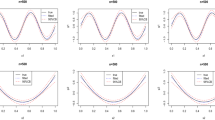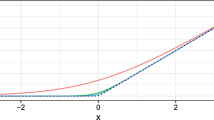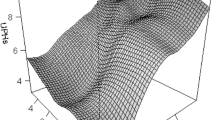Abstract
Common generalized linear models depend on several assumptions: (i) the specified linear predictor, (ii) the chosen response distribution that determines the likelihood and (iii) the response function that maps the linear predictor to the conditional expectation of the response. Generalized additive models (GAM) provide a convenient way to overcome the restriction to purely linear predictors. Therefore, the covariates may be included as flexible nonlinear or spatial functions to avoid potential bias arising from misspecification. Single index models, on the other hand, utilize flexible specifications of the response function and therefore avoid the deteriorating impact of a misspecified response function. However, such single index models are usually restricted to a linear predictor and aim to compensate for potential nonlinear structures only via the estimated response function. We will show that this is insufficient in many cases and present a solution by combining a flexible approach for response function estimation using monotonic P-splines with additive predictors as in GAMs. Our approach is based on maximum likelihood estimation and also allows us to provide confidence intervals of the estimated effects. To compare our approach with existing ones, we conduct extensive simulation studies and apply our approach on two empirical examples, namely the mortality rate in São Paulo due to respiratory diseases based on the Poisson distribution and credit scoring of a German bank with binary responses.








Similar content being viewed by others
References
Bollaerts, K., Eilers, P.H., Mechelen, I.: Simple and multiple P-splines regression with shape constraints. Br. J. Math. Stat. Psychol. 59(2), 451–469 (2006)
Bühlmann, P., Hothorn, T.: Boosting algorithms: regularization, prediction and model fitting. Stat. Sci. 22(4), 477–505 (2007)
Cameron, A.C., Trivedi, P.K.: Microeconometrics: Methods and Applications. Cambridge University Press, New York (2005)
Carroll, R.J., Fan, J., Gijbels, I., Wand, M.P.: Generalized partially linear single-index models. J. Am. Stat. Assoc. 92(438), 477–489 (1997)
Czado, C., Santner, T.J.: The effect of link misspecification on binary regression inference. J. Stat. Plan. Inference 33(2), 213–231 (1992)
de Boor, C.: A Practical Guide to Splines. Springer, New York (1978)
Eilers, P.H.C., Marx, B.D.: Flexible smoothing with B-splines and penalties. Stat. Sci. 11(2), 89–121 (1996)
Fahrmeir, L., Hamerle, A., Tutz, G.: Multivariate Statistische Verfahren. Walter de Gruyter GmbH & Co KG, Berlin (1996)
Fahrmeir, L., Kneib, T., Lang, S., Marx, B.: Regression: Models, Methods and Applications. Springer Science & Business Media, New Yor (2013)
Friedman, J.H., Stuetzle, W.: Projection pursuit regression. J. Am. Stat. Assoc. 76(376), 817–823 (1981)
Hand, D.J.: Measuring classifier performance: a coherent alternative to the area under the ROC curve. Mach. Learn. 77(1), 103–123 (2009)
Hastie, T., Tibshirani, R.: Generalized additive models. Stat. Sci. 1(3), 297–310 (1986)
Held, L., Sabanés Bové, D.: Applied Statistical Inference. Springer, Berlin (2014)
Ichimura, H.: Semiparametric least squares (SLS) and weighted SLS estimation of single-index models. J. Econom. 58(1), 71–120 (1993)
Jørgensen, B.: The delta algorithm and GLIM. Int. Stat. Rev./Rev. Int. Stat. 52(3), 283–300 (1984)
Klein, R.W., Spady, R.H.: An efficient semiparametric estimator for binary response models. Econometrica 61(2), 387–421 (1993)
Koenker, R., Yoon, J.: Parametric links for binary choice models: a Fisherian–Bayesian colloquy. J. Econom. 152(2), 120–130 (2009)
Leitenstorfer, F., Tutz, G.: Generalized monotonic regression based on B-splines with an application to air pollution data. Biostatistics 8(3), 654–673 (2007)
Leitenstorfer, F., Tutz, G.: Estimation of single-index models based on boosting techniques. Stat. Model. 11(3), 203–217 (2011)
Li, Q., Racine, J.S.: Nonparametric Econometrics: Theory and Practice. Princeton University Press, Princeton (2007)
Lobo, J.M., Jiménez-Valverde, A., Real, R.: AUC: a misleading measure of the performance of predictive distribution models. Glob. Ecol. Biogeogr. 17(2), 145–151 (2008)
Marra, G., Wood, S.N.: Practical variable selection for generalized additive models. Comput. Stat. Data Anal. 55(7), 2372–2387 (2011)
Marra, G., Wood, S.N.: Coverage properties of confidence intervals for generalized additive model components. Scand. J. Stat. 39(1), 53–74 (2012)
Marschner, I.C., et al.: glm2: fitting generalized linear models with convergence problems. R J. 3(2), 12–15 (2011)
Marx, B.D.: Varying-coefficient single-index signal regression. Chemom. Intell. Lab. Syst. 143, 111–121 (2015)
McCullagh, P., Nelder, J.A.: Generalized Linear Models, 2nd edn. Chapman & Hall, London (1989)
Muggeo, V.M., Ferrara, G.: Fitting generalized linear models with unspecified link function: a P-spline approach. Comput. Stat. Data Anal. 52(5), 2529–2537 (2008)
Pya, N.: scam: Shape Constrained Additive Models. R package version 1.2-2 (2017)
Pya, N., Wood, S.N.: Shape constrained additive models. Stat. Comput. 25(3), 543–559 (2015)
R Core Team: R: a language and environment for statistical computing. R Foundation for Statistical Computing, Vienna. https://www.R-project.org/ (2017)
Tutz, G., Petry, S.: Nonparametric estimation of the link function including variable selection. Stat. Comput. 22(2), 545–561 (2012)
Tutz, G., Petry, S.: Generalized additive models with unknown link function including variable selection. J. Appl. Stat. 43(15), 2866–2885 (2016)
Wang, J.L., Xue, L., Zhu, L., Chong, Y.S., et al.: Estimation for a partial-linear single-index model. Ann. Stat. 38(1), 246–274 (2010)
Weisberg, S., Welsh, A.: Adapting for the missing link. Ann. Stat. 22(4), 1674–1700 (1994)
Wood, S.: Monotonic smoothing splines fitted by cross validation. SIAM J. Sci. Comput. 15(5), 1126–1133 (1994)
Wood, S.N.: Generalized Additive Models: An Introduction with R, 2nd edn. CRC Press, Boca Raton (2017)
Wood, S.N., Fasiolo, M.: A generalized Fellner–Schall method for smoothing parameter optimization with application to tweedie location, scale and shape models. Biometrics (2017). https://doi.org/10.1111/biom.12666
Yu, Y., Ruppert, D.: Penalized spline estimation for partially linear single-index models. J. Am. Stat. Assoc. 97(460), 1042–1054 (2002)
Yu, Y., Wu, C., Zhang, Y.: Penalised spline estimation for generalised partially linear single-index models. Stat. Comput. 27(2), 571–582 (2017)
Acknowledgements
We thank Sebastian Petry for providing the code to the paper of Tutz and Petry (2016), such that we could compare our method with the boosting approach. We also want to thank two anonymous referees and an associate editor for their helpful comments improving this paper. Moreover, we acknowledge financial support by the German Research Foundation (DFG), Grant KN 922/4-2.
Author information
Authors and Affiliations
Corresponding author
Electronic supplementary material
Below is the link to the electronic supplementary material.
Appendix
Appendix
Algorithm 1
(FlexGAM1)

The inner iteration is done until the convergence of \(\varvec{\gamma }^{(k)}\), meaning \(\frac{\left| \left| \varvec{\gamma }^{(k)} - \varvec{\gamma }^{(k-1)} \right| \right| }{\left| \left| \varvec{\gamma }^{(k)} \right| \right| }~<~\varepsilon _1\). Then, the outer iteration is repeated. The inner and outer loops are iterated until the coefficients of \(\varPsi ^{(m)}\) are constant, meaning \(\frac{\left| \left| \varvec{\nu }^{(m)} - \varvec{\nu }^{(m-1)} \right| \right| }{\left| \left| \varvec{\nu }^{(m)} \right| \right| } < \varepsilon _2\).
Algorithm 2
(FlexGAM2)

Again the inner iteration is done until the convergence of \(\varvec{\gamma }^{(k)}\). Then, the outer iteration is repeated. The inner and outer loops are iterated until the coefficients of \(\hat{h}^{(m)}\) are constant, meaning \(\frac{\left| \left| \varvec{\nu }^{(m)} - \varvec{\nu }^{(m-1)} \right| \right| }{\left| \left| \varvec{\nu }^{(m)} \right| \right| }~<~\varepsilon _2\).
Rights and permissions
About this article
Cite this article
Spiegel, E., Kneib, T. & Otto-Sobotka, F. Generalized additive models with flexible response functions. Stat Comput 29, 123–138 (2019). https://doi.org/10.1007/s11222-017-9799-6
Received:
Accepted:
Published:
Issue Date:
DOI: https://doi.org/10.1007/s11222-017-9799-6




